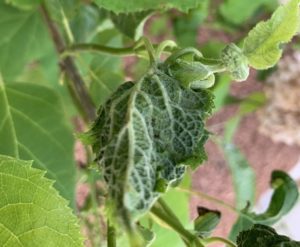Hello Fellow Readers, The violence added to the pandemic is hard to comprehend. A foundation of our column is finding lessons in our gardens and nature and taking these lessons into the garden of life. And so, especially this week, we long for wisdom to soothe the heaviness. Maybe a tad odd to some, but I found a lesson in the dilemma of hydrangea leaf-tiers.
Rasberry-colored perennials
Yesterday I helped Peggy and Ed add perennials in their garden on Culver’s Lake NJ, choosing an assortment of raspberry-colored lovelies. Such as Dianthus Periott, Salvia Sallyrosa’ Jumbo Pink,’ and Dianthus barbatus’ Purple Bi-Color’ (aka Pot Carnation). Plus ‘Cherry Tart’ Stonecrop (sedum). An extra treat is a Cora Louise Itoh Peony adorned with white blooms and stunning dark raspberry centers—a hybrid that stands tall without staking.
Hydrangea leaf-tiers “glue” two leaves together
After finishing, we walked around, enjoying things planted previously. Their Annabelle Hydrangea, the much-loved native beauty with white pompom flowers, looked odd. The tips of the branches have leaves perfectly glued together. I opened a few to find a gooey slug-type critter I didn’t recognize.
 Digging into the dilemma, I learned its likely Hydrangea Leaf-tier (Olethreutes or Exartema ferriferana). However, I didn’t find the half-inch long green caterpillar with a black head that feeds on the leaves and flower buds. Maybe the gooey little blobs I found would grow into that. Or they could be tiny slugs that entered the tent too, as they are fond of the moist spot for feeding.
Digging into the dilemma, I learned its likely Hydrangea Leaf-tier (Olethreutes or Exartema ferriferana). However, I didn’t find the half-inch long green caterpillar with a black head that feeds on the leaves and flower buds. Maybe the gooey little blobs I found would grow into that. Or they could be tiny slugs that entered the tent too, as they are fond of the moist spot for feeding.
Leaf-tiers grow into moths with brown and white markings that return in late fall and lay eggs, one on each stem. Come spring, they hatch and move to the tips of the branches to make their tent. They’re not a common pest but gone unchecked; they will destroy flower buds. For some odd reason, it seems they only choose smooth hydrangea (Hydrangea arborescens).
How to remedy Hydrangea Leaf-tiers
Removing them manually by unfolding the two leaves tied together and dropping the critter into soapy water for good riddance is the most effective, which seems right up there with manual slug removal, not ideal for those of us squeamish of such things. A less icky option is to clip the tips and throw them into a Ziploc and toss them in the trash. Tending to this soon after the leaves become glued will spare this year’s bloom as smooth hydrangea bloom on new wood.
There’s a biological insecticide with Btk (Bacillus thuringiensis kurstaki), naturally found in soil. It will kill caterpillars of moths and butterflies as they emerge from the egg but will not affect bees. One worries about monarchs, but once applied, Btk does not affect caterpillars beyond ten days. Monarch butterflies have a different caterpillar timeline than Leaf-tiers.
It’s fascinating how Leaf-tiers so cleverly defend themselves by creating a perfect tent of two leaves. Wouldn’t it be something if we could protect ourselves in much the same way? While hiding for safety makes sense, there’s more to be gained by taking action. And taking action may not be sharing the anger over the wrongs. Instead, living in the love of our neighbors and our community, which can spread and grow throughout the world. Garden Dilemmas? AskMaryStone@gmail.com (and now on your favorite Podcast App.)
Tip: If inundated with leaf-tiers, you can cut your hydrangea down to about four inches in early spring and toss the debris far from your hydrangea. Then manage the few that survive by removing them by hand.
A previous column you’ll enjoy – When to Prune Hydrangea, Deer!
Links to raspberry-colored lovelies:
Dianthus caryophyllus Odessa® Pierrot, Salvia nemorosa Sallyrosa™ ‘Jumbo Pink’ / Perennial Sage, Dianthus barbatus Barbarini ‘Purple Bi-Color’ / Pot Carnation, SunSparkler® Cherry Tart Stonecrop / Sedum ‘Cherry Tart’ Plant Patent #24,603, Cora Louise Itoh Peony / Paeonia (Intersectional hybrid) x ‘Cora Louise’




Hi Mary. I’ve had this pest on my arborencens “Annabelle” hydrangeas for many years. I simply pull the leaves apart that are stuck together. They seem to not like the bright sunlight. I’ve always had success with this method and have dozens of blooms every year. I cut them down to 18-24 inches early spring. Some of the early leaves are deformed but the newer and larger leaves are fine. As are the buds and flowers.
Thanks for the tip, Lorraine! Very encouraging to know that the other leaves, buds, and flowers will be unaffected. They sure are icky :^). Thanks so much, Mary